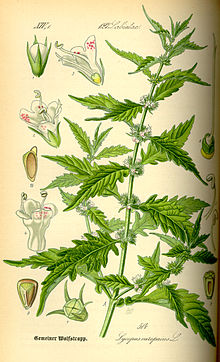Lycopus
| Lycopus | |
|---|---|

| |
| Lycopus europaeus[1] | |
| Scientific classification | |
| Kingdom: | Plantae |
| Clade: | Tracheophytes |
| Clade: | Angiosperms |
| Clade: | Eudicots |
| Clade: | Asterids |
| Order: | Lamiales |
| Family: | Lamiaceae |
| Subfamily: | Nepetoideae |
| Tribe: | Mentheae |
| Genus: | Lycopus L. |
| Synonyms[2] | |
| |
Lycopus (waterhorehound,[3] gypsywort, or bugleweed) is a genus in the family Lamiaceae. They are all herbaceous plants native to Europe, Asia, Australia, and North America.[2] The species are most often found in wetlands, damp meadows, and stream banks. Some of the wetland species have become endangered.[4]
Appearance[]
The genus includes only perennial species; they spread by both seeds and stems rooting as they grow along the ground. Small white flowers bloom in late summer on leaf axials. Leaves are bright green, pointed, lobed, and like all mints occur in opposite pairs. Some species start with curled purple leaves that unfurl to a bright green coloration. The species in this genus vary in size, but generally grow to about 3–4 ft (91–122 cm).[5]
Ethnobotanical history[]
The plant's juice yields black dye, supposedly used by the Roma in Europe to tan their skin to mimic Egyptians, hence the common name of Gypsywort for Lycopus europaeus. Apothecaries and herbalists used the leaves, stems, and flowers for their astringent and sedative qualities as well as for anxiety, tuberculosis, and palpitations.[5]
Fossil record[]
Fossil seeds of †Lycopus antiquus are known from the Middle Miocene strata of southern Russia, from the Miocene of Lower Lusatia, Germany, and from the Late Miocene strata of western Siberia and Ukraine. Lycopus antiquus has possibly been applied to more than one extinct species which were widely distributed in Europe and Siberia from the Miocene to the Pliocene. Extant Lycopus species whose fruits most resemble L. antiquus, are the East Asian Lycopus lucidus and the Eurasian Lycopus exaltatus.[6]
Species[]
- Prob. – Primorye region of Russia
- Lycopus americanus Muhl. ex W.P.C.Barton – American bugleweed - widespread across most of United States and Canada
- Lycopus amplectens Raf. – eastern United States
- Elliott – southeastern United States
- Lycopus asper Greene – rough bugleweed - western Canada, western + central United States
- R.Br. – Australian Gypsywort - Australia
- H.Lév. – Korean bugleweed[7] - China, Japan, Korea, Sakhalin, Kuril Islands
- Prob. – Primorye region of Russia
- H.E.Ahles ex Sorrie – North Carolina, South Carolina
- Lycopus europaeus L. – Gypsywort - Europe, North Africa, northern Asia; naturalized in New Zealand and North America
- L.f. – central + eastern Europe, Siberia, Central Asia, Xinjiang, Caucasus, Western Himalayas
- Kom. – Primorye region of Russia
- Hausskn. – Germany, Austria, Czech Republic, Greece (L. europaeus × L. exaltatus)
- Prob. – Kuril Islands
- Roll.-Germ. – Quebec
- Lycopus lucidus Turcz. ex Benth. – Traditional Chinese Medicine herb to make Lycopi rhizoma - China, Japan, Korea, Siberia, Russian Far East
- Moench – central + eastern United States
- Steele – Quebec, Ontario, eastern United States
- Prob. – Primorye region of Russia
- Lycopus uniflorus Michx. – northern bugleweed - Canada, United States. China, Japan, Korea, Russian Far East
- Lycopus virginicus L. – Virginia bugleweed/water-horehound - central + eastern United States
References[]
- ^ Prof. Dr. Otto Wilhelm Thomé Flora von Deutschland, Österreich und der Schweiz 1885, Gera, Germany
- ^ a b c Kew World Checklist of Selected Plant Families
- ^ "Lycopus". Natural Resources Conservation Service PLANTS Database. USDA. Retrieved 24 June 2015.
- ^ PLANTS Profile for Lycopus rubellus (taperleaf water horehound) | USDA PLANTS
- ^ a b Bremness, Lesley (1994). Eyewitness Handbook: Herbs. New York: DK Publishing.
- ^ The Pliocene flora of , south-eastern Belarus and its correlation with other Pliocene floras of Europe by Felix Yu. VELICHKEVICH and Ewa ZASTAWNIAK - Acta Palaeobot. 43(2): 137–259, 2003
- ^ English Names for Korean Native Plants (PDF). Pocheon: Korea National Arboretum. 2015. p. 529. ISBN 978-89-97450-98-5. Archived from the original (PDF) on 25 May 2017. Retrieved 16 December 2016 – via Korea Forest Service.
| Wikimedia Commons has media related to Lycopus. |
- Lycopus
- Lamiaceae genera
- Taxa named by Carl Linnaeus